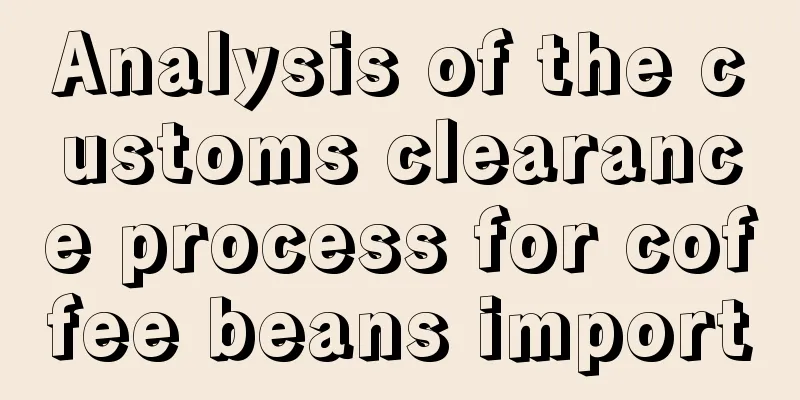Analysis of the customs clearance process for coffee beans import

Analysis of the customs clearance process for coffee beans importCoffee beans are a popular beverage ingredient, and a large amount of coffee beans are imported worldwide. However, due to issues such as international trade and food safety, the import customs clearance process of coffee beans is very important. This article will focus on the import customs clearance process of coffee beans. 1. Inspection and quarantine in the exporting countryIn the exporting country, all coffee beans to be exported need to be reviewed by the inspection and quarantine department. This step is mainly to ensure that the exported goods comply with the relevant laws and regulations and standards of the target country or region. Exporters need to provide relevant supporting documents and accept sampling tests, on-site inspections and other procedures. 2. Transportation and packagingAfter approval by outbound customs, the coffee beans will be shipped to the target country or region. The transportation method can be selected from different modes such as sea transportation, air transportation or land transportation. During the transportation process, packaging is very important. Proper packaging can protect the goods from damage and ensure that its quality and freshness are maintained. 3. Import declaration to target country or regionOnce the coffee beans arrive in the target country or region, the importer needs to make an import declaration to the local customs. This includes submitting relevant documents and information, such as invoices, packing lists, transportation contracts, etc. Customs will classify and evaluate the goods based on this information and determine the applicable tax rates and other fees. 4. Customs inspection and quarantineThe coffee beans are inspected and quarantined at the customs of the target country or region. This step is to ensure that the goods comply with local regulations and quality requirements. Customs may conduct sampling tests, laboratory analysis and other procedures on the goods to ensure their safety and quality. 5. Payment of Taxes and FeesAccording to the customs assessment results, the importer needs to pay the corresponding taxes and other fees. These fees may include import tax, value-added tax, customs clearance fees, etc. After the payment is completed, the goods can officially enter the country and obtain the customs clearance certificate. 6. Inventory and deliveryOnce the coffee beans have passed all the customs clearance procedures, they will be sent to the warehouse or distribution center for inventory and distribution. The importer needs to ensure that the quantity and quality of the goods are consistent with the contract and arrange the appropriate distribution method to deliver the coffee beans to the final sales point or processing plant. 7. Food safety supervisionAfter coffee beans enter the market, food safety regulatory authorities will conduct random inspections and supervision on them. This is to ensure that the coffee beans meet local food hygiene standards and do not cause any harm to consumers' health. If problems are found, relevant departments may take corresponding measures, such as recalling products and punishing illegal companies. SummarizeThe customs clearance process for coffee beans involves multiple links, including inspection and quarantine in the exporting country, transportation and packaging, import declaration in the target country or region, customs inspection and quarantine, payment of taxes and fees, inventory and distribution, and food safety supervision. Each link is very important and relevant laws and regulations and procedures must be strictly followed. Only after passing all customs clearance procedures and obtaining certificates can coffee beans officially enter the country and be put on the market. |
<<: Looking for cost-effective and delicious coffee beans, which brand do you recommend?
>>: Single origin coffee beans: the perfect combination of quality and flavor
Recommend
What is the ideal grind size for a semi-automatic coffee machine?
Semi-automatic coffee machines are a common type ...
Find out the truth about the best coffee and coffee beans on the market
Abstract: This article aims to explore the best c...
The ranking of domestic coffee bean varieties is announced
The ranking of domestic coffee bean varieties is ...
The prices of common coffee beans revealed!
The price of common coffee beans revealed Coffee ...
Yunnan Black Coffee Four Cats: Uncovering the Magical Effects
Yunnan Black Coffee Four Cats: Uncovering the Mag...
How many coffee beans are there in 200g
Basic knowledge and application of how much does ...
Coffee Daily, exploring the effects of long-term coffee drinking on the body
The effects of long-term coffee drinking on the b...
Can drinking coffee help you lose weight? The truth is revealed!
Can drinking coffee help you lose weight? The tru...
Top 10 Coffee Beans
Key factors affecting coffee bean quality The qua...
The best place to learn coffee in China
The best place to learn coffee in China is a prof...
Can I brew the ground coffee beans directly?
The relationship between coffee bean grinding fin...
Coffee Harvesting: The Journey from Farm to Cup
Coffee plantations in the fields The journey of c...
Coffee, a journey to explore the unknown taste buds
Coffee is a globally loved drink. It is not only ...
Round Coffee: Sexual Medicine or Health Supplement?
introduction Yuanqi coffee is a drink that has at...
Coffee milk powder brewing guide: the secret to perfect enjoyment of the mellow taste!
Coffee milk powder brewing guide: the secret to p...









